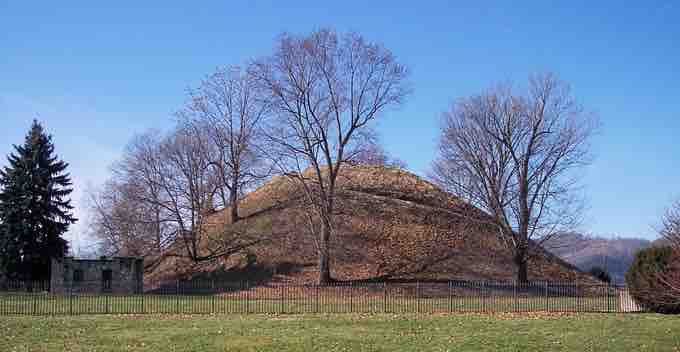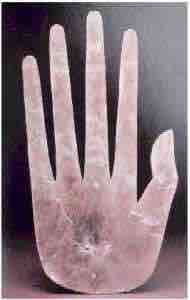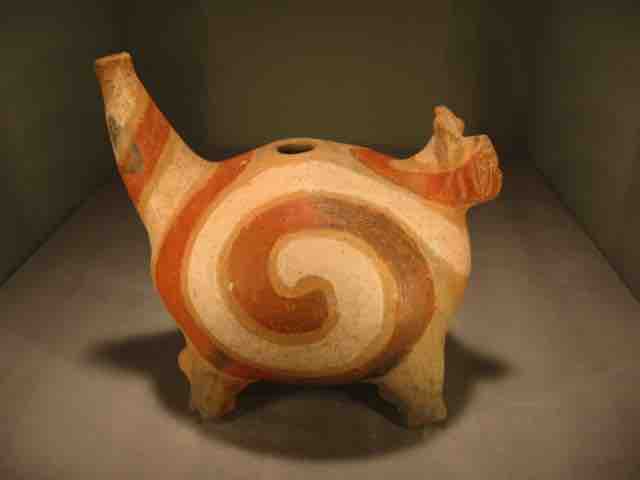The Eastern Woodlands cultures inhabited the regions of North America east of the Mississippi River since at least 2500 BCE.
Contact and trade were common among the many regionally distinct Woodlands cultures. They shared the practice of burying their dead in earthen mounds, which preserved many cultural artifacts. Burial mounds in North America are part of an archetypal tradition that includes the pyramids of ancient Egypt. These structures begin on the ground and extend upward toward the sky, acting as a connection between the earthly plane and the spiritual plane. Because of this trait, the cultures are collectively known as the Mound builders.

Grave Creek Mound
This mound, located in Moundsville, West Virginia was built by the Adena culture.
Early Woodland Period
Clay for pottery was typically tempered (mixed with non-clay additives) with crushed rock or limestone. Pots were usually made in a conoidal or conical jars with rounded shoulders, slightly constricted necks, and flaring rims. Pottery was most often decorated with a variety of linear or paddle stamps that created "dentate" (tooth-like) impressions, wavy line impressions, checked surfaces, or fabric-impressed surfaces. On the other hand, some pots were incised with geometric patterns or, more rarely, with pictorial imagery such as faces. Pots were coiled and paddled entirely by hand without the use of fast rotation such as a pottery wheel. Some were slipped or brushed with red ochre.
Harrington vessel
Ceramic vessel uncovered on Bussell Island, at the mouth of the Little Tennessee River in Loudon County, Tennessee. This pot belonged to the "Round Grave" culture, which corresponds roughly to the Late Archaic (c. 3000-1000 BCE) and Woodland periods. The pot's diameter is approximately six inches.
Ceramics made by the Deptford culture (800 BCE-700 CE), inhabitants of the southern East Coast and Gulf Coast, are the earliest evidence of an artistic tradition in this region. The Adena culture is another well-known example. They carved stone tablets with zoomorphic designs, created pottery, and fashioned costumes from animal hides and antlers for ceremonial rituals. Shellfish was a mainstay of their diet, and engraved shells have been found in their burial mounds.
Middle Woodland Period
The Middle Woodland Period was dominated by cultures of the Hopewell tradition (200-500 BCE). Their artwork encompassed a wide variety of jewelry and sculpture in stone, wood, and even human bone. Mound City, located on Ohio Highway 104 is a group of 23 earthen mounds constructed by the Hopewell culture. Each mound within the group covered the remains of a charnel house. After the Hopewell people cremated the dead, they burned the charnel house. They constructed a mound over the remains. They also placed artifacts, such as copper figures, mica, projectile points, shells, and pipes in the mounds.

Hopewell Art
This unique Hopewell sculpture was carved from Mica between 200 BCE and 500 CE.
Late Woodland Period
The Late Woodland Period (500-1000 CE) saw a decline in trade and in the size of settlements, and the creation of art likewise declined. During this period, the nomadic hunter-gatherer lifestyle gradually gave way to an agrarian way of life.
The Mississippian culture flourished in what is now the Midwestern, Eastern, and Southeastern United States from approximately 800 CE to 1500 CE (following the Late Woodland Period). After adopting maize agriculture the Mississippian culture became fully agrarian, as opposed to the hunting and gathering supplemented by part-time agriculture practiced by preceding woodland cultures. They built larger and more complex platform mounds than those of their predecessors, and finished and developed more advanced ceramic techniques, commonly using ground mussel shell as a tempering agent. Many were involved with the Southeastern Ceremonial Complex (SECC), a pan-regional and pan-linguistic religious and trade network. The majority of the information known about the SECC is derived from examination of the elaborate artworks left behind by its participants, including pottery, shell gorgets and cups, stone statuary, copper plates such as the Wulfing cache and long-nosed god maskettes.

Ceramic of Underwater Panther
This Mississippian culture ceramic effigy jug was found at Rose Mound in Cross County, Arkansas, and dates from 1400-1600.
Perhaps the most famous mound-building site from this period is Cahokia, which straddles the Mississippi River between the St. Louis, Missouri area and East St. Louis, Illinois. Cahokia was the largest and most influential urban settlement of the Mississippian culture that developed advanced societies across much of what is now the central and southeastern United States, beginning more than 1000 years before European contact. Cahokia's population at its peak in the thirteenth century, with a population of approximately 40,000.
Monks Mound is the largest structure and central focus of the city: a massive platform mound with four terraces, 10 stories tall, and the largest human-made earthen mound north of Mexico. The mound was built higher and wider over the course of several centuries through as many as ten separate construction episodes, as the mound was built taller and the terraces and apron were added.
Monks Mound
The concrete staircase is modern, but it is built along the approximate course of the original wooden stairs. Collinsville, IL.
While many Woodland cultures produced copper sculptures, Cahokia was the only Mississippian location to contain a copper workshop. The area contains the remains of three tree stumps thought to have been used to hold anvil stones. Analysis of copper found during excavations showed that it had been annealed. Artisans produced religious items, such as long-nosed god maskettes, ceremonial earrings with a symbolic shape, thought to have been used in fictive kinship rituals.
Mississippian Culture repoussé copper plates.
Three examples of Mississippian culture avian themed repoussé copper plates. The right-hand figure is one of the Spiro plates from Spiro Mounds in Oklahoma. The left hand figure is Wulfing plate A, one of Wulfing cache from Malden, Missouri. The middle plate is Rogan plate 1, from Etowah Mounds in Georgia. Examples of this type of artwork have been found as artifacts in many states throughout the Midwest and Southeast.
By the time of European contact the Mississippian societies were already experiencing severe social stress. With the social upsets and diseases introduced by Europeans many of the societies collapsed and ceased to practice a Mississippian lifestyle, with an exception being the Natchez people. Other tribes descended from Mississippian cultures include the Caddo, Choctaw, Muskogee Creek, Wichita, and many other southeastern peoples.